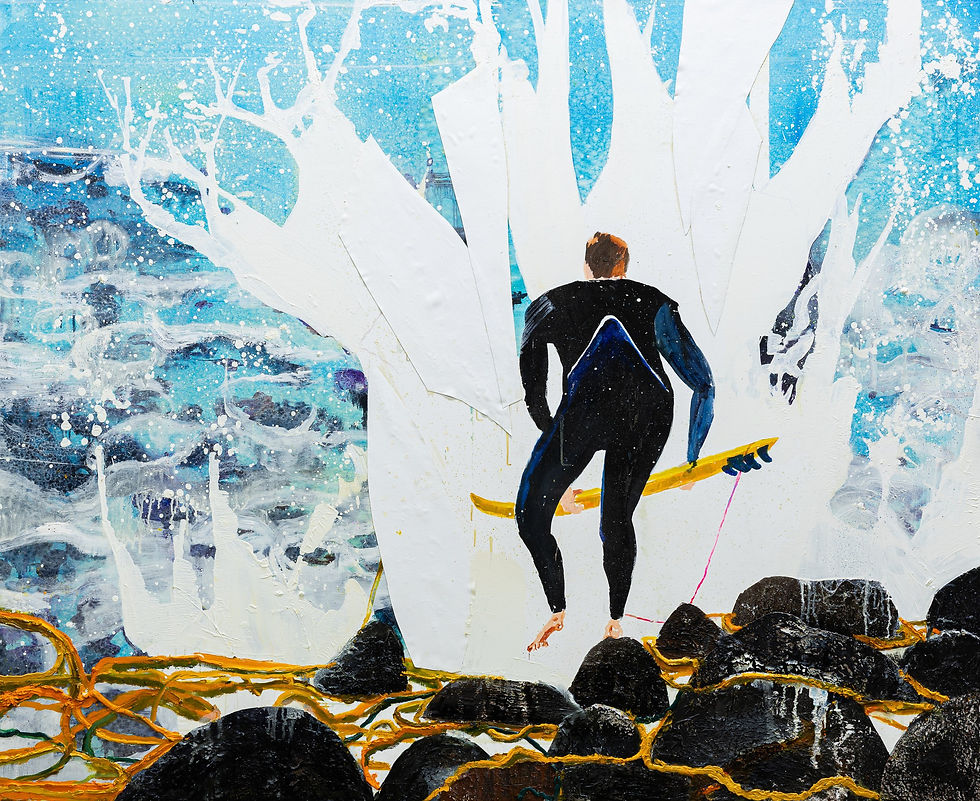The Unseen Door: William Mackinnon and the art of psychological landscapes
- Hinton Magazine

- Oct 1
- 2 min read
For William Mackinnon, painting is not simply an act of representation but a way of existing in the world. His canvases speak to the instability of life, to the messy mix of beauty, failure, memory and imagination that defines human experience. What might appear at first glance as a road or a suburban scene is rarely what it seems. With Mackinnon, the ordinary becomes uncanny, the everyday opens onto something larger.

His imagery is grounded in lived experience yet hovers at the threshold of the magical. Country lanes, pool hoses, rubbish bins and speed bumps emerge as unlikely protagonists, elevated into symbols that carry weight far beyond their modest forms. A road marking becomes a gesture of trust. A speed bump takes on the rhythm of parenthood. In Mackinnon’s hands, the banal turns lyrical, charged with psychological intensity.
The artist’s biography seeps into this vision. Dividing his life between Ibiza and Melbourne, Mackinnon inhabits a world of departures and returns, of pathways lit only in part, of constant movement between relationships and places. That rhythm feeds his recurring motifs of highways and shadowed roads, images that feel less like landscapes and more like emotional maps. They speak to the universal experience of moving forward without knowing what lies ahead.

There is an alchemy in his process. Acrylics and oils meet automotive paints, glitter, plaster and liquid nail adhesive. He pours, flicks, sands and splatters surfaces until they resist, then yield. Trees appear to grow across a canvas, black expanses slowly reveal hidden depths, turquoise waters seem to shimmer with impossible freshness. Each surface carries the trace of chance, of obstacles transformed into new possibilities.
What results are works that are not passively viewed but physically felt. They fragment reality, overlapping humour with melancholy, intimacy with distance, order with improvisation. Mackinnon calls them psychological landscapes, and it is easy to see why. They embody the tension of being half in the world and half in the mind, capturing the contradictions of what it means to be alive.
At the centre of this practice is the conviction that disruption is not failure but potential. A painting that resists him becomes a challenge, a door to unexpected forms. The same principle underpins his vision of life itself. Obstacles and interruptions are thresholds, unseen doors that lead towards transformation. It is this philosophy that charges his art with both fragility and vitality.

For collectors and critics, Mackinnon’s work offers more than technical virtuosity. It offers an encounter with the emotional and psychological textures of contemporary life. His paintings remind us that meaning is often found in overlooked details, in fragments that reveal themselves only with time and attention. They invite us to stand in the tension between control and surrender, certainty and doubt.
William Mackinnon is not painting landscapes in the conventional sense. He is charting an interior world, where memory and imagination fuse with the physical environment. The terrain he offers is unpredictable, unsettling, often playful, and always alive. To enter one of his works is to step through an unseen door into the unstable, glittering threshold of human experience itself.
.png)
_edited.jpg)












Comments